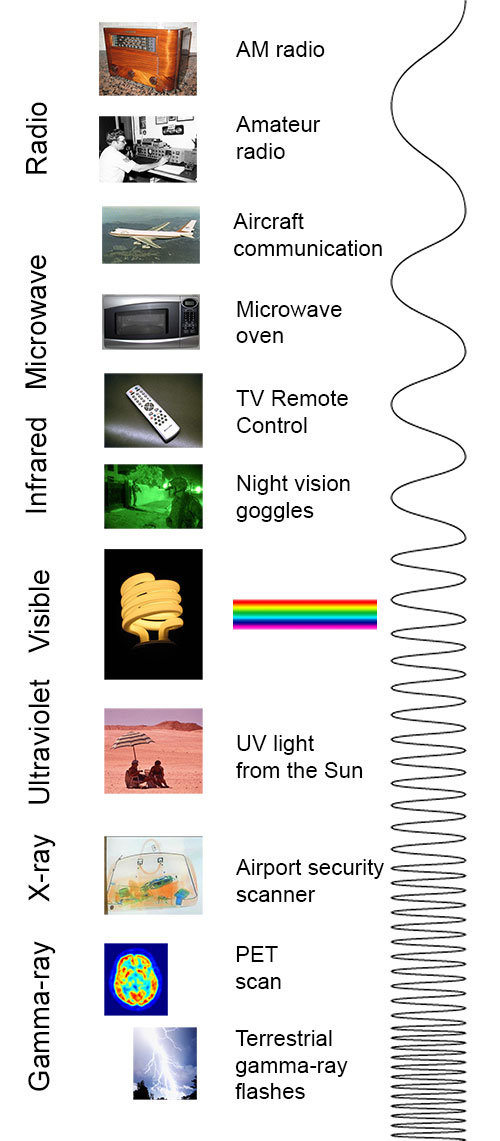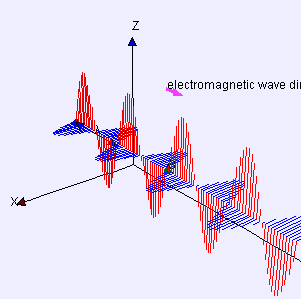Study Guide: Electromagnetism
Electromagnetism is one of the four fundamental forces (or interactions) of nature, which include the strong interaction, the weak interaction, and gravitation. It seems to be a combination of two fields—the electric field and the magnetic field.
We understand surprisingly little about electromagnetic energy, despite the fact that we are utterly reliant on it for everything from the electrical impulses in our brain and nervous system to global wireless communications. It warms the Earth, creates what we call light and colors, and produces rainbows and the Northern Lights.
Electromagnetic Energy Wave
An electromagnetic energy wave is a complex form of energy composed of oscillating electric and magnetic fields joined together and capable of conveying energy through space to the matter it meets.
By Lookang many thanks to Fu-Kwun Hwang and author of Easy Java Simulation = Francisco Esquembre - Own work, CC BY-SA 3.0, https://commons.wikimedia.org/w/index.php?curid=16874302
Electromagnetic Spectrum
The electromagnetic spectrum is the range of all types of electromagnetic radiation. Radiation is energy that travels and spreads out as it goes—the visible light from a lamp and the radio waves a radio station are two types of electromagnetic radiation. The other types of electromagnetic radiation are microwaves, infrared light, ultraviolet light, X-rays and gamma-rays.

Radio: Radio captures radio waves emitted by radio stations. Radio waves are also emitted by stars and gases in space.
Microwave: Microwave radiation cooks popcorn in minutes, but is also used by astronomers to learn about the structure of nearby galaxies.
Infrared: Night vision goggles pick up the infrared light emitted by our skin and other warm objects. In space, infrared light helps us map the dust between stars.
Visible: Our eyes detect visible light. Fireflies, light bulbs, and stars all emit visible light.
Ultraviolet: Ultraviolet radiation is emitted by the Sun and is the cause of skin tans and burns. “Hot” objects in space emit UV radiation as well.
X-ray: A dentist uses X-rays to image our teeth, and airport security uses them to see through our luggage. Hot gases in the Universe also emit X-rays.
Gamma ray: Doctors use gamma-ray imaging to see inside your body. The biggest gamma-ray generator of all is the Universe.
Qualities of Electromagnetic Waves
Electromagnetic energy follows predictable patterns from the moment it is formed to the the moment it meets matter. These patterns can be defined with mathematically precise equations.
One fact (or pattern) that all the equations have in common is that what the energy does to the the matter it interactis with is dependent on the wavelength or frequency of the wave. Exactly how each physical object (including living beings) is affected by electromagnetic energy is completely dependent on how that particular object blocks or interacts with particular electromagnetic waves.
An obvious example is our eyes. We see visible light because our eyes are designed to capture wavelengths of that specific size. Other wavelengths are invisible to us, athough they may be visible to other animals with different kinds of eyes.
On the other hand, visible light passes through clear glass without affecting the glass. Colored glass contains chemicals that absorb or reflect visible light at specific wavelengths while letting other wavelengths pass through undisturbed.
Absorption of Electromagnetic Energy
When electromagnetic energy reaches matter and is partially or totally absorbed by it, the electric and magnetic characteristics of the matter determine how much and at what frequency the energy is absorbed.
This can be seen by the absorption of electromagnetic energy in the atmosphere by oxygen, carbon dioxide, and other gases, which gives our atmosphere its color and warmth. The colors we see are the energy of reflected wavelengths. The warmth of the atmosphere is due to absorbed energy.
Electromagnetic Resonance
Absorption of electromagnetic energy is also affected by the length of whatever the wave meets. If the height of a person is close to the wavelength of the electromagnetic energy, resonance enhances the absorption of the energy. This is why the length of a radio antenna is important. Each antenna is designed to absorb specific wavelengths and frequencies based on it’s physical length.



